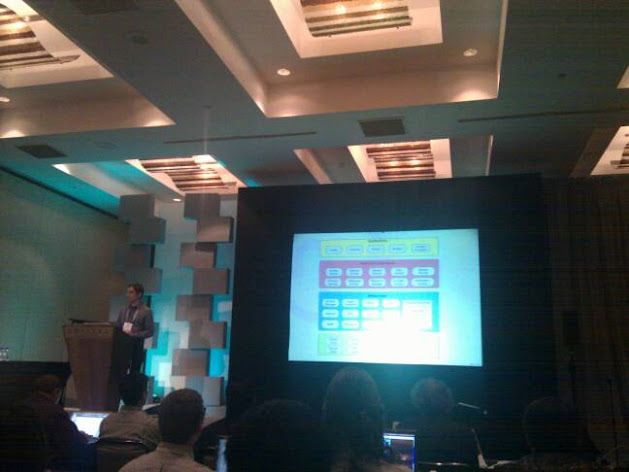Yesterday was the first day at the Android Builders Summit 2012, here in Redwood City, near San Francisco, California. My colleagues Grégory Clément and Maxime Ripard as well as myself are fortunate to attend this conference, and the contents of the first day were really interesting.
Amongst others:
- A talk from Karim Yaghmour, well-known for having worked on the original version of the Linux Trace Toolkit, on the Adeos patch, as well as for its activity around Android. He delivered a 30 minutes talk about Leveraging Linux’s history in Android, which covered the differences in architecture between a standard embedded Linux system and Android, as well as how to nicely integrate BusyBox or tools like the Linux Trace Toolkit into Android. The presentation was really impressive: in just 30 minutes, Karim covered a huge number of slides, and made several live demonstrations. It is also worth noting that Karim, following the direction that Bootlin has drawn 7 years ago, has decided to release his Android training materials under a Creative Commons BY-SA license.
- A panel with multiple kernel developers and people involved in Android on how to integrate the specific Android kernel patches into the mainline kernel. Not many new things learned here: the issue with the Android patches is that they add a lot of new userspace-to-kernel APIs, and such code is much much harder to get in mainline than conventional driver or platform code, since such APIs need to be maintained forever. Interestingly, Zach Pfeffer from Linaro pointed out the fact that the major problems with Android integration these days are not due to the kernel patches, but rather to the horrible binary blobs and related drivers that are needed for 3D acceleration ARM SoCs (Systems On a Chip).

Panel « Android and the Linux Kernel Mainline: Where Are We? » - A talk from Marko Gargenta on how to customize Android. He explained how to expose a specific Linux kernel driver functionality to Android applications, through a native C library, the JNI mechanism and an Android service, with complete details in terms of source code and build system integration. This presentation, just like last year’s presentation from Marko, was absolutely excellent. A lot of content, very dynamic presentation, a lot of things learned.
- A talk on how ADB (Android Debugger) works. The contents were really good as well here, with lots of details about the ADB architecture, some tips and tricks about its usage, and more. Unfortunately, the speaker was really not familiar with English, and most of its presentation was spent reading the slides. This is a bit unfortunate because the technical contents was really, really excellent. The slides are available at http://www.slideshare.net/tetsu.koba/adbandroid-debug-bridge-how-it-works.
- Using Android in safety-critical medical devices. This talk was not about technical issues, but rather about the reason for using Android in medical devices (get those devices connected together and collect some data to learn more about medical practices, their efficiency and cost) and also the legal requirements to get such devices validated by the Food and Drugs Administration in the US. A lot of useful arguments on how to convince managers that Android and Linux in general are usable in safety-critical medical devices.
- A talk about Over-The-Air updates in Android, which I didn’t attend, but my colleague Maxime Ripard and other attendees gave an excellent feedback about it. It detailed an advanced system for safely upgrading an Android system, using binary diffs and other techniques.

Customizing Android by Marko Gargenta, Marakana - The talk about Integrating Projects Using Their Own Build System Into the Android Build System had a really promising title and abstract, but unfortunately, the contents were disappointing. The speaker took 25 minutes just to explain how to build BusyBox (outside of any Android context) and then another 20 minutes to explain how to integrate it in the Android build system, on unreadable slides.
- The talk about Android Device Porting Walkthrough was really great. Benjamin Zores exhausted its time slot with a 1h15 talk instead of the 50 minutes slot allocated, but fortunately, it was the last talk of the day in this session. During this talk, Benjamin gave a huge amount of information and many details about various issues encountered in the process of adapting Android for an Alcatel business VoIP phone (the ones you see in business desks). Issues like filesystem layout, input subsystem configuration, touchscreen configuration, graphics and much much more were covered. Be sure to check out Benjamin slides at http://www.slideshare.net/gxben/android-device-porting-walkthrough.
- Finally, the day ended with a lightning talk session moderated by Karim Yaghmour. Lightning talks are really nice, because in less than 5 minutes, you quickly hear about a project or an idea. When the speaker is not good or the topic uninteresting, you know that after 5 minutes, you’ll hear someone else speaking about a different topic. The lightning talk on the integration of GStreamer in Android was really interesting, as was the lightning talk from Karim about its CyborgStack initiative, which creates an upstream Android source to integrate all the Android modifications that will never be mainlined by Google. See Karim slides at http://www.cyborgstack.org/sites/default/files/cyborgstack-120213.pdf for details.
And now, it’s time for breakfast, before the conferences of the second day of this Android Builders Summit.
